Neonatal General
Category: Abstract Submission
Neonatology General 11: Lung
358 - Bone Health and Bronchopulmonary Dysplasia in Preterm Infants
Monday, April 25, 2022
3:30 PM - 6:00 PM US MT
Poster Number: 358
Publication Number: 358.440
Publication Number: 358.440
Ariel Tarrell, University of Utah School of Medicine, Salt Lake City, UT, United States; Sabrina Malone Jenkins, University of Utah, Salt Lake City, UT, United States; Matthew Grinsell, University of Utah, Salt lake City, UT, United States; Bradley A. Yoder, University of Utah, Salt Lake City, UT, United States
- AT
Ariel Tarrell, MD
Neonatology Fellow
University of Utah
Salt Lake City, Utah, United States
Presenting Author(s)
Background: The gold standard for diagnosis of metabolic bone disease (MBD) of prematurity is dual energy x-ray absorptiometry (DXA), which measures bone mineral content (BMC). Another technique, bone quantitative ultrasound (QUS), uses speed of sound (SOS) as a measure of composite bone health. Bronchopulmonary dysplasia (BPD) is a known risk factor for MBD leading to an increased need for MBD recognition in this population.
Objective: The purpose of this study is to evaluate the relationship of bone health as determined by DXA and QUS in preterm infants with BPD.
Design/Methods: 41 infants born ≤ 32 weeks or ≤ 1800 grams were included in this prospective observational study secondary analysis. Bone health was assessed by both DXA (Hologic) and QUS (Omnisense 8000) at near-term corrected gestational age (CGA). DXA and QUS were obtained within 7 days of each study. Bone status results were compared to total number of days on oxygen, oxygen need at 36 weeks CGA, and severity of BPD.
Results: Infants were born at a mean age of 29.8 + 2.2 weeks and a mean weight of 1315 + 429 grams. Bone studies were obtained at a mean CGA of 37.7 + 2.1 weeks. SOS by QUS correlated with total days on oxygen (R2 = 0.270, p < 0.001) while BMC by DXA did not (R2 = 0.00, p > 0.05). An oxygen need at 36 weeks CGA was associated with a significantly lower SOS (p < 0.05), but not BMC (p > 0.05). There was a demonstrated difference in mean SOS between BPD classes (p < 0.05) but no difference in BMC between BPD classes (p > 0.05). Mean SOS was higher in infants with less respiratory disease consistent with better bone health (see figure).Conclusion(s): SOS by QUS, but not BMC by DXA, correlates with the total number of days of oxygen therapy and demonstrated a difference with receiving oxygen at 36 weeks CGA. QUS correlated to bone health status by severity of BPD. In the high-risk BPD population, QUS may offer additional information about bone health beyond the BMC that DXA measures.
Figure: Mean SOS and BPD class. Mean SOS by BPD class shown. Error bars represent the 95% confidence limit.
Mean SOS by BPD class shown. Error bars represent the 95% confidence limit.
Objective: The purpose of this study is to evaluate the relationship of bone health as determined by DXA and QUS in preterm infants with BPD.
Design/Methods: 41 infants born ≤ 32 weeks or ≤ 1800 grams were included in this prospective observational study secondary analysis. Bone health was assessed by both DXA (Hologic) and QUS (Omnisense 8000) at near-term corrected gestational age (CGA). DXA and QUS were obtained within 7 days of each study. Bone status results were compared to total number of days on oxygen, oxygen need at 36 weeks CGA, and severity of BPD.
Results: Infants were born at a mean age of 29.8 + 2.2 weeks and a mean weight of 1315 + 429 grams. Bone studies were obtained at a mean CGA of 37.7 + 2.1 weeks. SOS by QUS correlated with total days on oxygen (R2 = 0.270, p < 0.001) while BMC by DXA did not (R2 = 0.00, p > 0.05). An oxygen need at 36 weeks CGA was associated with a significantly lower SOS (p < 0.05), but not BMC (p > 0.05). There was a demonstrated difference in mean SOS between BPD classes (p < 0.05) but no difference in BMC between BPD classes (p > 0.05). Mean SOS was higher in infants with less respiratory disease consistent with better bone health (see figure).Conclusion(s): SOS by QUS, but not BMC by DXA, correlates with the total number of days of oxygen therapy and demonstrated a difference with receiving oxygen at 36 weeks CGA. QUS correlated to bone health status by severity of BPD. In the high-risk BPD population, QUS may offer additional information about bone health beyond the BMC that DXA measures.
Figure: Mean SOS and BPD class.
 Mean SOS by BPD class shown. Error bars represent the 95% confidence limit.
Mean SOS by BPD class shown. Error bars represent the 95% confidence limit.